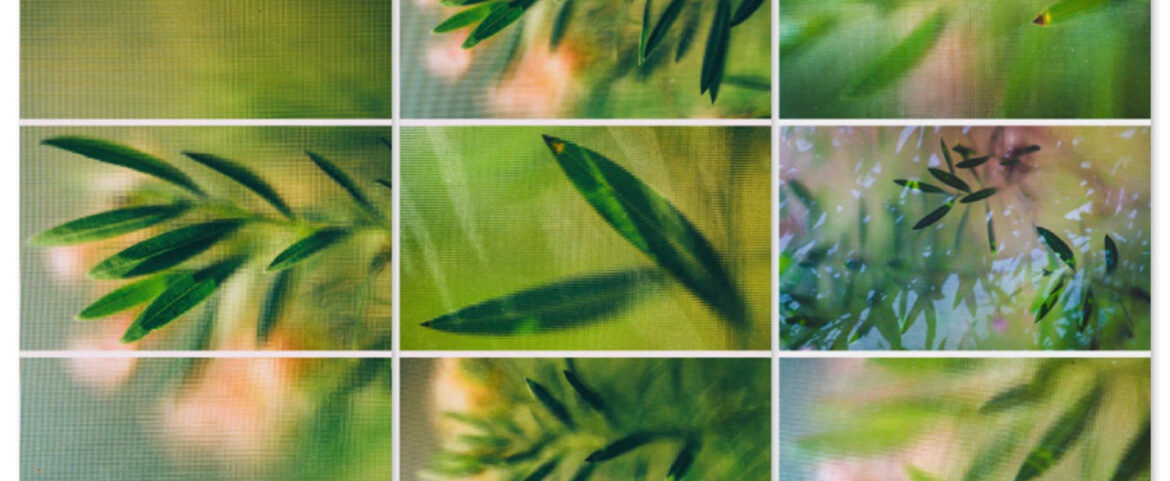
Imagine billboards
generating energy
Thanks to new technologies, solar panels can now be invisible and can easily integrate anywhere. Solar energy can now be seen as a new artistic medium that can stimulate creativity and contribute to a more responsible society.
Photo-Synthesis is a poetical series of artwork presented by Compáz that demonstrates solar energy from a technological as well as artistic perspective. Plants convert sunlight into chemical energy through a process known as photosynthesis. Solar panels convert sunlight into electricity. Both produces energy. The projects are here to showcase the possibilities of modern technologies as well as remind people of our roots in nature.
Photo—Synthesis exhibition will be composed of three 1646 mm x 999 mm (60 solar cells) panels. Built as a triptych composing one single image. Three panels combined can generate up to a 290 KWh of energy, which translates to 870 hours of a television broadcast. The artwork is conceived to work outside and to produce electricity when facing the sun. Additionally, it can stand inside as an artwork showing its great potential and the magnificent photographical work done by David Hartwell.
Supported by Swissnex in China, the installations will be exhibited simultaneously at two spots in Beijing: first, at the 5th International Art and Science Exhibition (TASIES 2019) at the National Museum of China from November 2 to 30; second, at the Art Factory Café in 798 Art Zone (4 Jiuxianqiao Rd., Qixingdong Str.) from November 2 to 28. Free and no RSVP required.

Along with the Photo-Synthesis exhibition, we have Swiss design studio fabric | ch‘s work Atomized Functioning coming to TASIES 2019 from November 2 to 30 at the National Museum of China. Atomized Functioning is part of an ongoing series of works: Atomized Functioning, an algorithmic and machine learning based project, a software that creates and saves endlessly new architectural configurations in real-time 3d, according to dynamic data, constraints and conceptual rules related to the general work and experimental program of fabric.

On the basis of this program, the defined rules constantly seek new functional associations related to the physical-digital state of our contemporary environment (“post-digital”, “anthropocenic” or “capitalocenic” according to some). It also digs and looks, in some specific configurations, for sustainable reconfigurations of these elements. The work in progress carried out by the AI is continuously displayed on screens of different sizes and quantities, accordingly.
Atomized Functioning has been exhibited at the House der elektronischen Künste (Basel, CH), in 2019 as a standalone piece during 3 months (exhibition Entangled Realities, 09.05-11.08.2019), and in a configuration that has been used prior to the show to help carry out the curatorial and scenographic work: Atomized (curatorial) Functioning.
About TASIES 2019
The Tsinghua University’s Art and Science International Exhibition and Symposium was co-founded by Nobel-Prize-winning physicist Prof. Tsung-Dao Lee and esteemed artist Prof. Wu Guanzhong. The event aims to reveal the inner relation between art and science through demonstration as well as academic discussion of frontier exploration, domestic and international, in art and science. It’s also founded in the hope of expanding and deepening artistic and scientific studies, improving innovation level, as well as facilitating harmonious development in both fields. So far, four successful sessions of the event have been held respectively in 2001, 2006, 2012, and 2016.
The 5th Art and Science International Exhibition and Symposium will take palce on November 2 and 3 at the National Museum of China (RSVP link here) The symposium theme is AS-Helix: The Integration of Art and Science in the Age of Artificial Intelligence. The AS-Helix exhibition and symposium encourage dialogues and reflections in relevant fields such as human cognition, production revolution, future education, art paradigm, design innovation, health and medical care, and sustainable development. It also explores how art and science can be deeply integrated in the age of AI, and how we can promote sustainable development based on the concept of consultation, contribution and shared benefits.
